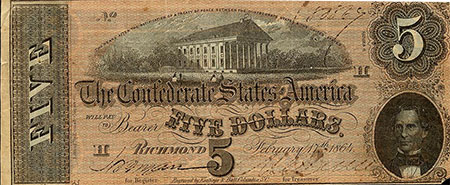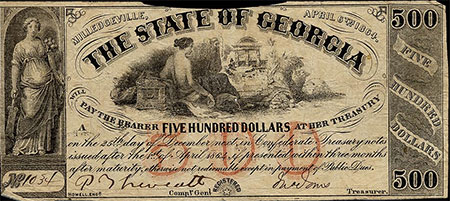
Many aspects of the Civil War which didn’t necessarily occur directly in Atlanta or even in Georgia, had a direct impact on Atlanta’s citizens. When the South seceded from the Union, it almost immediately fell into a financial crisis. Problems of inflation plagued the Confederacy throughout the war. There was not a great deal of control over or organization of currency production, with states, banks and even private companies issuing their own paper money as haphazardly as the federal government.
MARBL has a number of issues of Confederate currency in its collections in various denominations. In Atlanta, we can imagine that the citizens of the city were using both federal notes as well as those which were printed nearby in Milledgeville. Both of these issues, as well as those from banks and other states can be found in several collections in MARBL.

$5 Bill from the Confederate States of America,
Confederate Miscellany Collection
The south made a number of fatal mistakes when it came to its financial state, not the least of which was the creation of currency without funding to back it up. However, it was a strong Union blockade on Confederate exportation and Europe’s declining reliance on Southern cotton that lessened the South’s monetary intake. As well, Northerners were contributing to the currency problems by circulating counterfeit bills. The South did not have its own printing press for money, nor did it have the same level of engravers or quality of paper as the North. As a result, Confederate currency was highly susceptible to being duplicated fraudulently.

$500 Bill Issued by the Confederate State of Georgia,
Confederate Miscellany Collection
With the overabundance of currency printed, inflation was rampant in the Confederacy. Items, which immediately prior to the war would have been worth reasonable amounts, rose exponentially in price during the early 1860s. The value of a Confederate dollar declined steadily over the course of the war. In the summer of 1863, the worth of the dollar slipped to 8 cents and by the time of Lee’s surrender, it was down to 1.5 cents. By 1865, Confederate money was considered worthless and was only kept as a war souvenir or play money. (Heidler & Heidler)
Confederate currency did not become a true collector’s item until the centennial in the 1960s. After that, prices soared and today some of the more rare items are valued in the $10,000s, a far cry from its worth in 1865.
References:
Current, R.N. (Ed.). (1993). Encyclopedia of the Confederacy. New York: Simon and Schuster
Heidler, D.S., Heidler, J.T. (Eds.). (2000). Encyclopedia of the American
Civil War: a political, social and military history. Santa Barbara, CA: ABC-CLIO